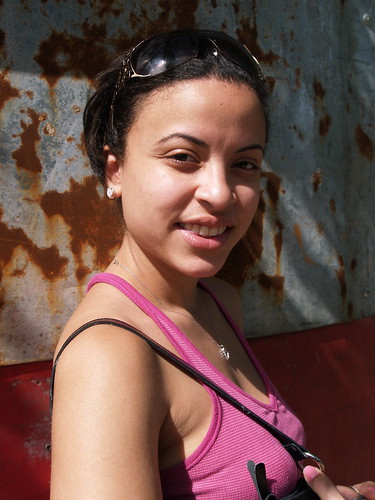
I have found myself challenged by portraits recently.
I think that the personal is political, to borrow an oft quoted phrase. In this, I’m exploring how my own positioning as a young, white, American, bisexual woman with a camera can fit into Trinidad culture, or not, and how this will effect what photographs I can and will take.
I am concerned and mindful of a recent history of colonial powers in Trinidad, and in the Caribbean in general, but have only the faintest specifics of this history in relation to photography in Trinidad. I was studying abroad in South Africa the semester before this one, and there was also questioning my positionality, and desire to create portraits. I chickened out, if I can use such a term. What I mean is that I avoided asking for portraits of strangers. I became hyper aware of the history there of documentary photography in it’s focus on phenotypical documentation to support racial doctrine establishing that Europeans were more evolved physically, and therefore superior. Rather, I took portraits of friends in social situations, or portraits in my work environment.
With this knowledge of colonial interaction with relation to photography in South Africa, I am very unsure of how to approach portraits here in Trinidad. In South Africa, I stayed clear of shooting out of the window of a mini-bus while driving through various townships, and never asked for photographs, or took photographs of people living in these giant slums. In Trinidad, an equivalent is Sea Lots. I brought up this same discomfort there, as I was encouraged to photograph people liming around the shacks constructed of corrugated steel and found wood. However, as in South Africa, I found that I could not feel comfortable enough to snap a picture of men standing in front of a rusted car, for instance.
There seems to be an understanding too, that in introducing myself as a student, that I will be taking non-exploitative photographs. The assumption that I will not be gaining anything from the capture of a particular light on someone’s face is a fallacy. Even if it is so much as a simple accolade from a professor, or the inclusion of such a photograph in a brochure for this Trinity-in-Trinidad program, I am gaining.
I feel as though such documentation, by my part, is not for any greater purpose. I do not doubt or stand against wanting to document extreme poverty in a way that inspires action, but I do not think that I am situated to do that. As an American student particularly, I don’t have a feeling of importance enough to think that my image of Sea Lots and it’s inhabitants will inspire a change in the social, political and class struggles of this particularly placed group.
Part of my worries stem too, from the fact that I am in effect, publishing these images, without express permission to post them on this blog, on my flickr account, or to show the images to others. In knowing someone, I can at least feel more comfortable that the images I produce are consensual to the highest degree possible, and should offense be taken to an image, it can be remedied because of close contact, and assumed review of images.
Avoiding portraits is certainly a way to avoid interpersonal interaction, and a way to avoid more intrapersonal dialogue on the ethics of such image taking. With that, I have no qualms in stating that it is easier for me to photograph people that I know, rather than attempting portrait photographer of relative strangers.
Christopher Cozier and I have discussed my feelings on portraiture here to some degree, and have agreed that a challenge for myself would be to attempt portraits of Trinidadians as themselves, in a location like their home. In my mind, this would therefore require an exchange, and a redefining of own subjectivity as the photographer of a subject. This would refer to the “looking back” notion that Christopher Cozier reintroduced to my Trinidadian experience. Portraits are powerful representations of people, and I feel, that in order to create a powerful image, I must also allow for the greater exposure of myself as a photographer to subject, enough to allow for an interchange and exchange of being. Then, I can feel like I am creating a portrait of a person, rather than an economical, social, racial, or sexual situation or position.
The last thing that I want to do is to take a photograph of an individual, in order to represent an entire location and an entire people. This type of namelessness for a subject, the stripping of individuality and freedom of personal expression is at odds with my own positionality and relationship to other human beings and my personal politics. It’s too reductionist in my mind, to expect, in the same way, that my own feelings here represent every artist, so I won’t claim that my feelings here are representational of all the posters. I am however, of this mindset, and am alternately looking forward to and simultaneously dreading such photographic interactions.
I expect that this photographic interchange will teach me much more about myself than about what my images can say….
0 comments:
Post a Comment